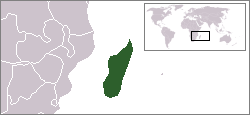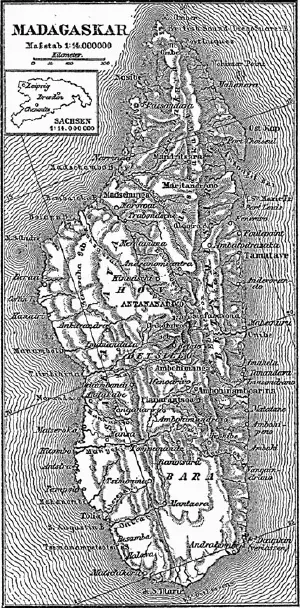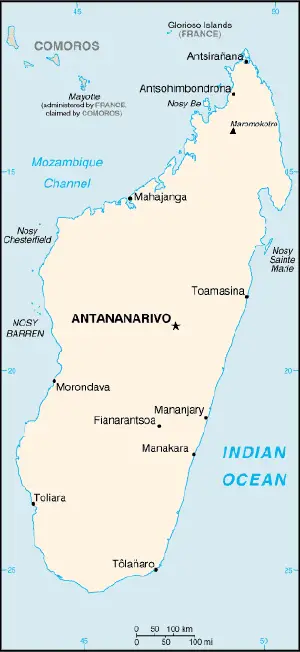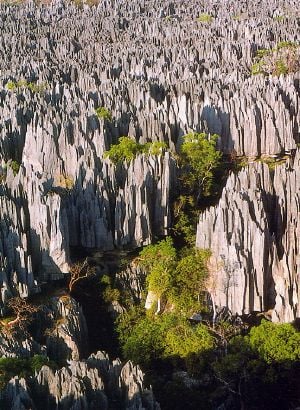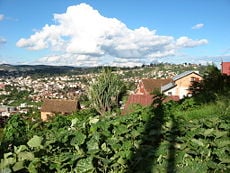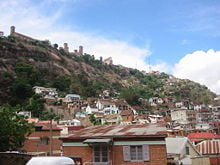Madagascar
- This article is about the African nation. For the 2005 animated film, see Madagascar (film), and for the ship that went missing in 1853, see Madagascar (ship).
| Repoblikan'i Madagasikara République de Madagascar Republic of Madagascar |
||||||
|---|---|---|---|---|---|---|
|
||||||
| Motto: Tanindrazana, Fahafahana, Fandrosoana (Malagasy: Ancestral-land, Liberty, Progress) |
||||||
| Anthem: Ry Tanindraza nay malala ô (Oh, Our Beloved Ancestral-land) |
||||||
| Capital (and largest city) | Antananarivo 18°55′S 47°31′E | |||||
| Official languages | Malagasy, French1 | |||||
| Government | Republic | |||||
| - | President | Marc Ravalomanana | ||||
| - | Prime Minister | Jacques Sylla | ||||
| Independence | From France | |||||
| - | Date | 26 June, 1960 | ||||
| Area | ||||||
| - | Total | 587,041 km² (45th) 226,597 sq mi |
||||
| - | Water (%) | 013% | ||||
| Population | ||||||
| - | July 2005 estimate | 18,606,000 (56th) | ||||
| - | 1997 census | 16,099,246 | ||||
| GDP (PPP) | 2005 estimate | |||||
| - | Total | $15.82 billion (118th) | ||||
| - | Per capita | 900 (169th) | ||||
| Currency | Malagasy ariary (MGA) |
|||||
| Time zone | MSK (UTC+3) | |||||
| - | Summer (DST) | not observed (UTC+3) | ||||
| Internet TLD | .mg | |||||
| Calling code | +261 | |||||
| 1Malagasy is the national language according to the Constitution. French is considered a de facto official language. | ||||||
Madagascar, officially the Republic of Madagascar, is an island nation in the Indian Ocean, off the eastern coast of Africa. The main island, also called Madagascar, is the fourth largest island in the world. It is the home of five percent of the world's plant and animal species, 80 percent of which are unique to Madagascar. Among its most notable examples of biodiversity are the lemur infraorder of primates, three endemic bird families and six endemic baobab species. The adjective (language, ethnicity and citizenship) derived from Madagascar is Malagasy (pronounced "mal-gazh"). The primary language spoken in Madagascar is Malagasy.
History
Archeologists place the first arrival of humans on the island to the years between 200 and 500 C.E., when seafarers from southeast Asia, probably Borneo or the southern Celebes, arrived after crossing thousands of miles of open ocean in their outrigger canoes. The feat represented the western-most branch of the great Austronesian expansion.
The written history of Madagascar began in the 7th century, when Arabs established trading posts along the northwest coast. European contact began in the 1500s, when Portuguese sea captain Diego Dias sighted the island after his ship became separated from a fleet going to India. In the late 17th century, the French established trading posts along the east coast. From about 1774 to 1824, it was a favourite haunt for pirates, including Americans, one of whom brought Malagasy rice to South Carolina.
During the Middle Ages, the chiefs of the different settlements on the island began to extend their power through trade with Madagascar's Indian Ocean neighbors, notably North Africa, the Middle-east and India. Large chiefdoms began to dominate considerable areas of the island. Among these were the Sakalava chiefdoms of the Menabe, centered in what is now the town of Morondava, and of Boina, centered in what is now the provincial capital of Mahajanga (Majunga). The influence of the Sakalava extended across what is now the provinces of Antsiranana, Mahajanga and Toliara. With the domination of the Indian Ocean by the British fleet and the end of the Arab slave trade, the Sakalava would lose their power to the emerging Merina threat.
Beginning in the 1790s, Merina rulers succeeded in establishing hegemony over the major part of the island, including the coast. In 1817, the Merina ruler and the British governor of Mauritius concluded a treaty abolishing the slave trade, which had been important in Madagascar's economy. In return, the island received British military and financial assistance. British influence remained strong for several decades, during which the Merina court was converted to Presbyterianism, Congregationalism, and Anglicanism.
France invaded Madagascar in 1883 in what became known as the first Franco-Hova War (Hova being the name of the Merina aristocrats), eeking to restore property that had been confiscated from French citizens. The British accepted the imposition of a French protectorate over Madagascar in 1885 in return for eventual control over Zanzibar (now part of Tanzania) and as part of an overall definition of spheres of influence in the area. Absolute French control over Madagascar was established by military force in 1895-1896, and in 1896, the French Parliament voted to annex Madagascar. The 103-year-old Merina monarchy ended with the royal family being sent into exile in Algeria.
During World War II, Malagasy troops fought in France, Morocco, and Syria. In 1947, with French prestige at low ebb, a Malagasy nationalist uprising was suppressed after several months of bitter fighting in which 100,000 people were killed. The French subsequently established reformed institutions in 1956 under the Loi Cadre (Overseas Reform Act), and Madagascar moved peacefully toward independence. The Malagasy Republic was proclaimed on October 14, 1958, as an autonomous state within the French Community. A period of provisional government ended with the adoption of a constitution in 1959 and full independence on June 26, 1960.
Politics
Madagascar's first President, Philibert Tsiranana, was elected when his Social Democratic Party gained power at independence in 1960 and was reelected without opposition in March 1972. From this time until the government of Didier Ratsiraka was formed in June 1975 was a time of unrest and transition for Madagascar. During the 16 subsequent years of President Ratsiraka's rule, Madagascar continued under a government committed to revolutionary socialism based on the 1975 Constitution establishing a highly centralized state. During this period a strategy of nationalization of private enterprises, centralization of the economy and "Malgasization" of the education system crippled the economy, leaving traces even today of a highly centralized economic system and a high level of illiteracy. National elections in 1982 and 1989 returned Ratsiraka for a second and third 7-year presidential term. For much of this period, only limited and restrained political opposition was tolerated, with no direct criticism of the president permitted in the press.
Beginning in the late 1980s, the Ratsiraka regime came under increasing pressure to make fundamental changes. In response to a deteriorating economy, Ratsiraka relaxed socialist economic policies and instituted some liberal, private-sector reforms. These, along with political reforms like the elimination of press censorship in 1989 and the formation of more political parties in 1990.
In March 1992, a widely representative National Forum organized by the FFKM (Malagasy Christian Council of Churches) drafted a new Constitution. Troops guarding the proceedings clashed with pro-Ratsiraka "federalists" who tried to disrupt the forum in protest of draft constitutional provisions preventing the incumbent president from running again. The text of the new Constitution was put to a nationwide referendum in August 1992 and approved by a wide margin, despite efforts by federalists to disrupt balloting in several coastal areas.
Presidential elections were held on November 25, 1992, after the High Constitutional Court had ruled that Ratsiraka could become a candidate. Runoff elections were held in February 1993, and the leader of the Hery Velona movement, Albert Zafy, defeated Ratsiraka. Zafy was sworn in as President on March 27, 1993. After President Zafy's impeachment by the National Assembly in 1996 and the short quasi-presidency of Norbert Ratsirahonana, the 1997 elections once again pitted Zafy and Ratsiraka, with Ratsiraka this time emerging victorious. A National Assembly dominated by members of President Ratsiraka'a political party AREMA subsequently passed the 1998 Constitution, which considerably strengthened the presidency.
In December 2001, a presidential election was held in which both major candidates claimed victory. The Ministry of the Interior declared incumbent Ratsiraka of the AREMA party victorious. In April of 2002 the the High Constitutional Court named Marc Ravalomanana the victor. A political crisis followed in which Ratsiraka supporters cut major transport routes from the primary port city to the capital city, a stronghold of Ravalomanana support. Sporadic violence and considerable economic disruption continued until July 2002 when Ratsiraka and several of his prominent supporters fled to exile in France.
After the end of the 2002 political crisis, President Ravalomanana began many reform projects, forcefully advocating "rapid and durable development" and the launching of a battle against corruption. December 2002 legislative elections gave his newly formed TIM (Tiako-I-Madagasikara) (I Love Madagascar) Party a commanding majority in the National Assembly.
Following the crisis of 2002, the President replaced provincial governors with appointed PDSs (Presidents des Delegations Speciales). Subsequent legislation established a structure of 22 regions to decentralize administration. In September 2004, the Government named 22 Regional Chiefs, reporting directly to the President, to implement its decentralization plans.
Government
In March 1998, Malagasy voters approved a revised constitution. The principal institutions of the Republic of Madagascar are a presidency, a parliament (National Assembly and Senate), a prime ministry and cabinet, and an independent judiciary. The president is elected by direct universal suffrage for a 5-year term, renewable twice.
The National Assembly consists of 160 representatives elected by direct vote every 5 years. The last election was held in December 2002. The Senate consists of 90 senators, two-thirds elected by local legislators and other Grand Electors and one-third appointed by the president, all for 6-year terms. A prime minister and council of ministers carries out day-to-day management of government. The president appoints the prime minister.
The prime minister and members of Parliament initiate legislation, and the government executes it. The president can dissolve the National Assembly. For its part, the National Assembly can pass a motion of censure and require the prime minister and council of ministers to step down. The Constitutional Court approves the constitutionality of new laws. Madagascar is also part of the Indian Ocean Commission.
Administrative Divisions
|
During the second republic (1975-1991), Madagascar was divided into five levels of government:
|
Today, there are four levels of division:
|
The constitution of 1992 ruled that the country should be decentralized into territorial entities. The name, number, and limits of territorial entities should be determined by law. The law passed by the national assembly in 1994 defined three such entity levels: region (faritra), department (departemanta) and commune (kaominina). The communes were created in 1996.
With Didier Ratsiraka back in power, the constitution was changed in 1998, to include and specifically mention six autonomous provinces, divided into undefined regions and communes. The autonomous provinces, having the same names and territories as the already existing provinces, were created in 2000.
During the power struggle after the presidential elections in 2001, five of those provinces, whose governors supported Ratsiraka, declared themselves independent from the republic. The new president, Ravalomanana, replaced the provincial governments by special delegations, appointed by the president. This effectively means that the autonomous provinces have ceased to exist as such, although it remains unclear whether they will remain in place.
Provinces and regions
Madagascar is divided into six autonomous provinces (faritany mizakatena), which in turn are divided into 22 regions:
|
|
|
Geography
The east coast of Madagascar has lowlands leading to steep bluffs and central highlands. The Tsaratanana Massif in the north has volcanic mountains. The west coast has many protected harbors and broad plains, while the southwest is a plateau and desert region.
There are two seasons: it is hot and rainy from November to April, and cooler and dry from May to October. Southeastern trade winds dominate, and there are occasional cyclones.
Ecology
Madagascar's long isolation from the neighboring continents has resulted in a unique mix of plants and animals, many found nowhere else in the world; some ecologists refer to Madagascar as the "eighth continent".
The eastern, or windward side of the island is home to tropical rainforests, while the western and southern sides of the island, which lie in the rain shadow of the central highlands, are home to tropical dry forests, thorn forests, and deserts and xeric shrublands. Madagascar's dry deciduous forests have been preserved generally better than the eastern rainforests or the high central plateau, presumably due to historically less population density and scarcity of water. There has been some slash-and-burn activity in the eastern and western dry forests as well as the central high plateau, reducing certain forest habitat and applying pressure to some endangered species. Slash-and-burn is a method sometimes used by shifting cultivators to create short term yields from marginal soils. When practiced repeatedly, or without intervening fallow periods, the nutrient poor soils may be exhausted or eroded to an unproductive state. The resulting increased surface runoff from burned lands has caused significant erosion and resulting high sedimentation to western rivers.
Economy
Structural reforms began in the late 1980s, initially under pressure from international financial institutions, notably the World Bank. An initial privatization program (1988-1993) and the development of an export processing zone (EPZ) regime in the early 1990s were key milestones in this effort. A period of significant stagnation from 1991-96 was followed by 5 years of solid economic growth and accelerating foreign investment, driven by a second wave of privatizations and EPZ development. Although structural reforms advanced, governance remained weak and perceived corruption in Madagascar was extremely high. During the period of solid growth from 1997 through 2001, poverty levels remained stubbornly high, especially in rural areas. A six-month political crisis triggered by a dispute over the outcome of the presidential elections held in December 2001 virtually halted economic activity in much of the country in the first half of 2002. Real GDP dropped 12.7% for the year 2002, inflows of foreign investment dropped sharply, and the crisis tarnished Madagascar's budding reputation as an AGOA standout and a promising place to invest. Following resolution of the crisis, the economy rebounded with GDP growth of over 10% in 2003.
Following the 2002 political crisis, Madagascar developed a recovery plan in collaboration with the private sector and donors and presented it at a "Friends of Madagascar" conference organized by the World Bank in Paris in July 2002. Donor countries demonstrated their confidence in the new government by pledging $1 billion in assistance over five years. The Malagasy Government identified road infrastructure as its principle priority and underlined its commitment to public-private partnership by establishing a joint public-private sector steering committee.
The Madagascar-U.S. Business Council was formed in Madagascar in 2002. The U.S.-Madagascar Business Council was formed in the United States in May 2003, and the two organizations continue to explore ways to work for the benefit of both groups.
Madagascar's sources of growth are tourism; textile and light manufacturing exports (notably through the EPZs); agricultural products (the country is the world's leading producer of vanilla, accounting for about half the world's export market); and mining. Tourism targets the niche eco-tourism market, capitalizing on Madagascar's unique biodiversity, unspoiled natural habitats, and lemur species. Exports from the EPZs, located around Antananarivo and Antsirabe, consist the most part of garment manufacture, targeting the US market under AGOA and the European markets under the Everything But Arms (EBA) agreement. Agricultural exports consist of low volume high value products like vanilla, litchies and essential oils. Mining investment is growing following the introduction of a new law opening the country up to foreign mining companies. A large mining investment by Rio Tinto in the Fort Dauphin region, to exploit ilmenite (titanium dioxide), is expected by late 2005, and other projects in ilmenite (Ticor/Kumba in Tulear) and nickel (Dynatec/Implats near Tamatave) could also be launched in the future.
Foreign relations
Madagascar, which has historically been perceived as on the margin of mainstream African affairs, eagerly rejoined the African Union in July 2003 after a 14-month hiatus triggered by the 2002 political crisis. From 1978 until 1991, then-President Ratsiraka emphasized independence and nonalignment and followed an "all points" policy stressing ties with socialist and radical regimes, including North Korea, Cuba, Libya, and Iran. Taking office in 1993, President Albert Zafy expressed his desire for diplomatic relations with all countries. Early in his tenure, he established formal ties with South Korea and sent emissaries to Morocco.
Starting in 1997, globalization encouraged the government and President Ratsiraka to adhere to market-oriented policies and to engage world markets. External relations reflect this trend, although Madagascar's physical isolation and strong traditional insular orientation have limited its activity in regional economic organizations and relations with its East African neighbors. It enjoys closer and generally good relations with its Indian Ocean neighbors — Mauritius, Réunion, and Comoros. Active relationships with Europe, especially France, Germany, and Switzerland, as well as with Britain, Russia, Japan, India, and China have been strong since independence. More recently, President Ravalomanana has cultivated strong links with the United States, and Madagascar was the first country to benefit from the Millennium Challenge Account (MCA). Madagascar is also a member of the International Criminal Court with a Bilateral Immunity Agreement of protection for the US-military (as covered under Article 98).
President Ravalomanana has stated that he welcomes relations with all countries interested in helping Madagascar to develop. He has consciously sought to strengthen relations with Anglophone countries as a means of balancing traditionally strong French influence.
Demographics
Madagascar's population is predominantly of mixed Asian and African origin, though those who are visibly Asian in appearance and culture are the minority, found in the highland regions. Recent research suggests that the island was uninhabited until Malay seafarers arrived between about 2,000 to 1,500 years ago. Recent DNA research shows that the Malagasy are approximately of half Malay and half East African stock, although some Arab, Indian and European influence is present along the coast. The Malagasy language shares some 90% of its basic vocabulary with the Maanyan language from the region of the Barito River in southern Borneo.
Subsequent migrations from both the Pacific and Africa further consolidated this original mixture, and 36 separate tribal groups emerged. Asian features are most predominant in the Merina (3 million) ; the coastal people (called côtiers) are of more clearly African origin.
The largest coastal groups are the Betsimisaraka (1.5 million) and the Tsimihety and Sakalava (700,000 each).
The Malagasy language is of Malayo-Polynesian origin and is generally spoken throughout the island. French is spoken among the educated population of this former French colony. English is becoming more widely spoken and in 2003 the government began a pilot project of introducing the teaching of English into the primary grades of 44 schools, with hopes of taking the project nationwide. Many Peace Corps volunteers are serving to further this effort and train teachers.
In the first Constitution of Madagascar (1960), Malagasy and French were named the "official languages of the republic". In the current Constitution, there is no official language mentioned, instead Malagasy is named the "national language". In a case where a citizen had claimed unconstitutional the publication of official documents in the French language only, The High Constitutional Court has observed in its decision[1] that, in the absence of a language law, French still has the character of an official language.
Religion
Approximately half of the country's population practices traditional religions, which tend to emphasize links between the living and the dead. The Merina in the highlands particularly tend to hold tightly to this practice. They believe that the dead join their ancestors in the ranks of divinity and that ancestors are intensely concerned with the fate of their living descendants. The Merina and Betsileo reburial practice of famadihana, or "turning over the dead" celebrate this spiritual communion. In this ritual, relatives' remains are removed from the family tomb, rewrapped in new silk shrouds, and returned to the tomb following festive ceremonies in their honor.
About 45% of the Malagasy are Christian, divided almost evenly between Catholics and Protestants. Many incorporate the cult of the dead with their religious beliefs and bless their dead at church before proceeding with the traditional burial rites. They also may invite a pastor to attend a famadihana. The Roman Catholic church is open to its members continuing these practices, while more conservative protestant denominations tend to condemn them to be superstitions or demon worship that should be abandoned. Many of the Christian churches are influential in politics. The best example of this is the Malagasy Council of Churches (FFKM) comprised of the four oldest and most prominent christian denominations (Roman Catholic, Reformed Protestant, Lutheran and Anglican). In the coastal regions of the provinces of Mahajanga and Antsiranana (Diego Suarez), Muslims constitute a significant minority. Muslims are divided between those of Malagasy ethnicity, Indo-Pakistanis, and Comorians.
Culture
- Music of Madagascar
- List of writers from Madagascar
Salegy is a popular music form. There is a sudden interest in American culture and European popular culture, which is eroding the more traditional culture, and especially the music.
Trivia
- Madagascar and Mauritania are the only countries in the world not to use decimal-based currency. Both nations instead use multiples of five.
- The Malagasy economy took a brief downturn during the 1980s when Coca-Cola, the world's leading purchaser of vanilla, switched to the New Coke formula that contained synthetic vanillin. The situation reversed itself when the company reintroduced its classic formula.
- According to the latest census data, the majority of Malagasy citizens (about 52%) practice indigenous religious beliefs rather than world religions.
ReferencesISBN links support NWE through referral fees
- Matthew E. Hules, et al (2005). The Dual Origin of the Malagasy in Island Southeast Asia and East Africa: Evidence from Maternal and Paternal Lineages. American Journal of Human Genetics, 76:894-901, 2005.
- CIA World Factbook [2]
- US State Department [3]
External links
Ecology
Government
- Embassy of Madagascar in Canada government information and links
- Embassy of Madagascar in Washington DC
- National Assembly of Madagascar official site
- The Malagasy Government official site
News
- allAfrica.com - Madagascar news headline links
Overviews
- BBC News Country Profile - Madagascar
- CIA World Factbook - Madagascar
- Library of Congress - Country Study: Madagascar data as of August 1994
Directories
- Open Directory Project - Madagascar directory category
- Stanford University - Africa South of the Sahara: Madagascar directory category
- The Index on Africa - Madagascar directory category
- University of Pennsylvania - African Studies Center: Madagascar directory category
- Yahoo! - Madagascar directory category
Tourism
- Photos of Madagascar by region
- Photos
- Travel guide to Madagascar from Wikitravel
- Lonely Planet - Madagascar tourist guide
- National Parks and Reserves
Other links
- Consulate of Madagascar counsular mission to Hungary
Sovereign states
Algeria ·
Angola ·
Benin ·
Botswana ·
Burkina Faso ·
Burundi ·
Cameroon ·
Cape Verde ·
Central African Republic ·
Chad ·
Democratic Republic of the Congo ·
Republic of the Congo ·
Comoros ·
Côte d'Ivoire ·
Djibouti ·
Egypt1 ·
Equatorial Guinea ·
Eritrea ·
Ethiopia ·
Gabon ·
The Gambia ·
Ghana ·
Guinea-Bissau ·
Guinea ·
Kenya ·
Lesotho ·
Liberia ·
Libya ·
Madagascar ·
Malawi ·
Mali ·
Mauritania ·
Mauritius ·
Morocco ·
Mozambique ·
Namibia ·
Niger ·
Nigeria ·
Rwanda ·
Senegal ·
Seychelles ·
Sierra Leone ·
Somalia ·
South Africa ·
Spain2 ·
Sudan ·
Swaziland ·
São Tomé and Príncipe ·
Tanzania ·
Togo ·
Tunisia ·
Uganda ·
Zambia ·
Zimbabwe
Dependencies | Unrecognized
British Indian Ocean Territory (UK) ·
French Southern and Antarctic Lands (France) ·
Mayotte (France) ·
Réunion (France) ·
St. Helena3 (UK)
|
Puntland ·
Somaliland ·
Sahrawi Arab Democratic Republic
1 Partly in Asia. 2 Mostly in Europe. 3 Includes the dependencies of Ascension Island and Tristan da Cunha.
Credits
New World Encyclopedia writers and editors rewrote and completed the Wikipedia article in accordance with New World Encyclopedia standards. This article abides by terms of the Creative Commons CC-by-sa 3.0 License (CC-by-sa), which may be used and disseminated with proper attribution. Credit is due under the terms of this license that can reference both the New World Encyclopedia contributors and the selfless volunteer contributors of the Wikimedia Foundation. To cite this article click here for a list of acceptable citing formats.The history of earlier contributions by wikipedians is accessible to researchers here:
The history of this article since it was imported to New World Encyclopedia:
Note: Some restrictions may apply to use of individual images which are separately licensed.


